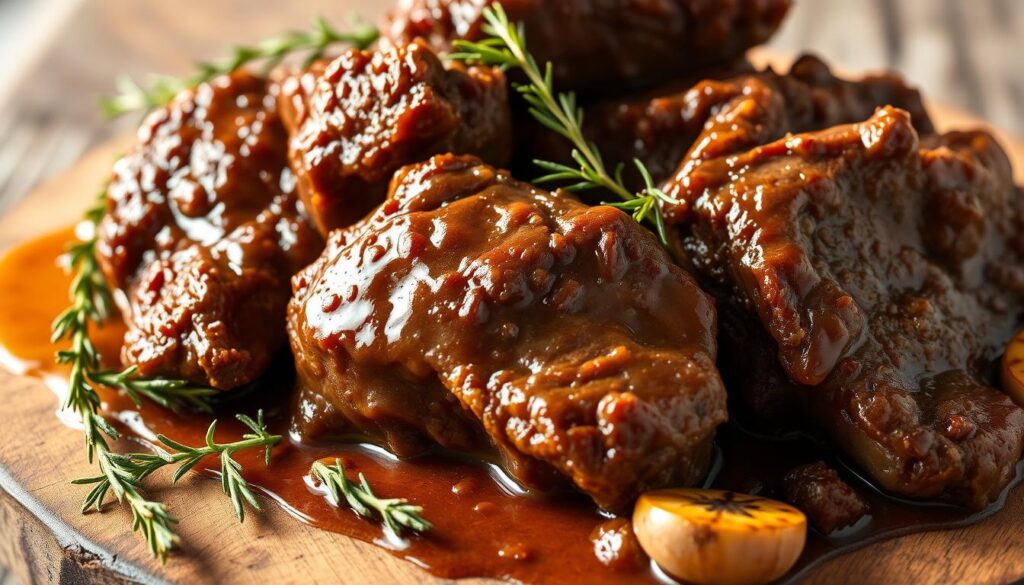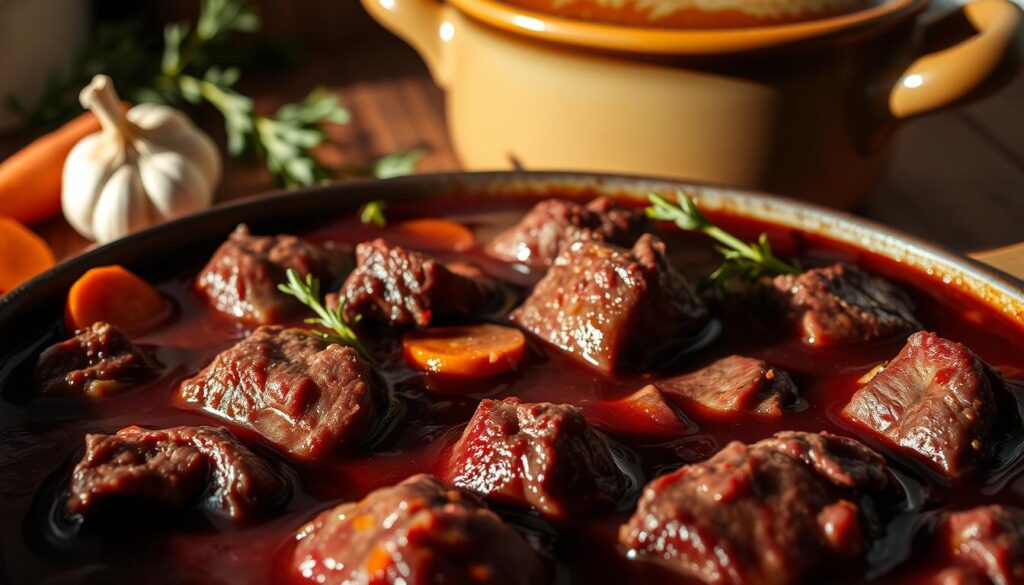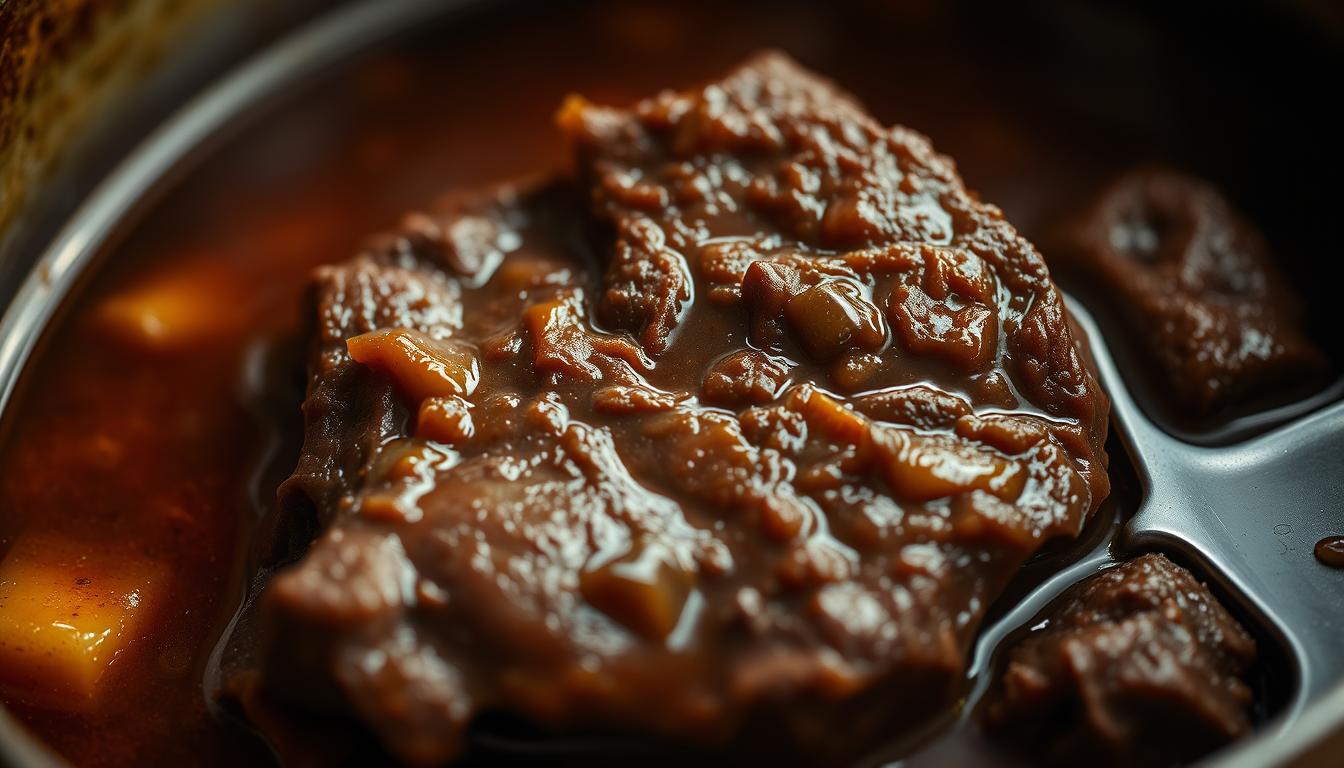How to Cook Beef Cheeks in a Slow Cooker for Perfect Tenderness
Every home cook dreams of making a meal that turns simple meat into a special dish. Beef cheeks are a perfect example of this magic. They become tender and rich when cooked slowly and with care.
slow cooked beef cheeks
tender beef cheeks
Beef cheeks are a hidden treasure in cooking. They are tough because they work hard in a cow’s life. But, a slow cooker can turn them into a soft, delicious dish that wows everyone.
If you’re a pro chef or just want to make your beef cheeks recipe better, this guide is for you. We’ll show you how to make slow cooked beef cheeks that everyone will love. You’ll learn how to bring out the best in this often-forgotten cut of meat.
Table of Contents
Understanding Beef Cheeks: A Cut Above the Rest
Beef cheeks are a true culinary treasure. They turn simple meat into a memorable dining experience. These cuts are loved by chefs for their rich flavor and ability to become tender and soft.
Explore the world of beef cheeks. See why they’re a hit with both home cooks and professional chefs.
What Makes Beef Cheeks Unique
Beef cheeks are special for several reasons:
- Intense muscle usage creates deep, rich flavor
- High collagen content ensures exceptional tenderness
- Perfect for slow-cooking methods
- Extremely flavorful compared to other beef cuts
The Science Behind Their Texture
The secret to tender beef cheeks is their muscle structure. The cow’s facial muscles make the meat tough. But, when slow-cooked, it becomes incredibly soft.
Nutritional Profile and Benefits
Beef cheeks are not just tasty; they’re also nutritious. They offer:
- High-quality protein
- Essential amino acids
- Rich source of iron and zinc
- B-complex vitamins
Learning about beef cheeks opens up a world of culinary possibilities. It takes your cooking from ordinary to extraordinary.
Essential Equipment and Ingredients for Slow Cooking Beef Cheeks
To make a tasty beef cheek stew, you need the right tools and ingredients. Your kitchen tools are key to turning tough beef cheeks into a tender dish. It’s one that will melt in your mouth.
Essential Cooking Equipment
- 6-8 quart slow cooker
- Heavy-bottomed skillet for searing
- Sharp kitchen knife
- Cutting board
- Meat thermometer
For red wine beef cheeks, choose top-notch ingredients. They should match the rich meat’s flavors. The right mix of liquids and seasonings can make your dish amazing.
Key Ingredients for Perfect Beef Cheek Stew
- Beef cheeks (2-3 pounds)
- Full-bodied red wine
- Beef stock
- Fresh herbs (thyme, rosemary)
- Aromatics (garlic, onions)
- Salt and black pepper
When picking beef cheeks, look for meat with lots of marbling and a deep color. The slow cooking will make the meat tender. It’s perfect for your stew.
Wine Selection Tips
For red wine beef cheeks, pick a strong red wine like Cabernet Sauvignon or Merlot. The wine’s acidity will tenderize the meat. It will also add depth to your stew’s flavor.
Preparing Your Beef Cheeks for Slow Cooking
Getting beef cheeks ready for cooking needs careful steps. Whether you’re making instant pot beef cheeks or beef cheek tacos, the right prep is key. This ensures the meat is tender and full of flavor.
Before cooking, you must handle these tough cuts with care. Beef cheeks come from the cattle’s facial muscle. This makes them naturally tough, needing special prep.
Trimming and Cleaning Tips
Trimming is vital for tasty instant pot beef cheeks. Here’s what to do:
- Remove excess silver skin and tough membranes
- Trim visible thick fat layers
- Rinse meat under cold water
- Pat dry with paper towels
Pre-cooking Seasoning Guide
Seasoning makes beef cheeks truly special. Salt and pepper are your base, but add more:
- Use kosher salt for deeper flavor
- Try spice blends like smoked paprika
- Add garlic powder and dried herbs
Marination Techniques
Marinating beef cheek tacos is key. Use acidic ingredients to break down the meat:
- Red wine vinegar
- Citrus juices
- Buttermilk
- Worcestershire sauce
Marinate for 4-8 hours in the fridge. This lets flavors deeply soak into the meat. Your beef cheeks will be tender and full of rich taste.
The Ultimate Beef Cheeks Recipe for Slow Cooker

Learning to cook beef cheeks in a slow cooker takes time and the right steps. This top recipe turns tough meat into a tender, delicious dish. It will wow anyone who tries it.
To make smoked beef cheeks, you’ll need these ingredients:
- 4-6 beef cheeks (approximately 2-3 pounds)
- 2 tablespoons olive oil
- Sea salt and freshly ground black pepper
- 2 large onions, chopped
- 4 garlic cloves, minced
- 1 cup beef broth
- 1/2 cup red wine
- 2 sprigs fresh thyme
- 2 bay leaves
First, season your beef cheeks well with salt and pepper. The key to tender meat is proper preparation. Dry the beef cheeks with paper towels for perfect browning.
Heat olive oil in a large skillet. Sear the beef cheeks until they’re golden brown. This step adds flavor and a tasty crust.
Put the seared beef cheeks in your slow cooker. Add onions, garlic, broth, wine, thyme, and bay leaves. Cover and cook on low for 8-10 hours. The meat will be very tender.
| Nutrient | Amount per 100g |
|---|---|
| Calories | 240 |
| Protein | 20g |
| Fat | 18g |
Pro tip: Let the beef cheeks rest for 15 minutes after cooking. This helps the juices spread evenly. Your dish will be even more flavorful and tender.
Step-by-Step Slow Cooking Process
Learning to slow cook beef cheeks is key to a great dish. It takes patience and skill to turn tough meat into tender, flavorful bites.
Searing and Browning Methods
Start by searing the beef cheeks to add flavor. Dry the meat with paper towels for better browning. Season with salt and pepper, then sear in a hot skillet until golden brown on all sides.
- Use high heat for maximum flavor development
- Sear for 2-3 minutes per side
- Avoid overcrowding the pan
Temperature and Timing Guidelines
For tender beef cheeks, control the temperature. Cook at a low heat to soften the meat.
| Cooking Method | Temperature | Cooking Time |
|---|---|---|
| Low Setting | 195°F | 8-10 hours |
| High Setting | 275°F | 4-6 hours |
Adding Vegetables and Aromatics
Boost your dish with vegetables and herbs in the last hours. Root vegetables and herbs make a big difference.
- Add sturdy root vegetables midway through cooking
- Introduce delicate herbs in the final hour
- Use aromatics like garlic, onions, and thyme for depth of flavor
Pro tip: Make sure your slow cooker is half full to keep it moist and prevent burning.
Wine and Stock Combinations for Rich Flavor

To make braised beef cheeks truly special, you need the right liquid. Red wine turns simple beef cheeks into a dish fit for a feast. The right wine and stock can change your dish from good to great.
Here are some top wines for red wine beef cheeks:
- Cabernet Sauvignon: Robust and full-bodied
- Merlot: Smooth with subtle fruit notes
- Syrah/Shiraz: Intense flavor profile
- Burgundy: Classic pairing for beef dishes
Choosing the right stock is also key. Beef stock is the best choice for beef cheeks, adding a deep meaty taste. You can also mix beef and vegetable stocks for a richer flavor.
Want to skip the wine? Use beef broth and a bit of balsamic vinegar instead. This keeps the flavor deep but is alcohol-free.
For the best red wine beef cheeks, mix your liquids carefully. Start with two parts stock to one part wine. This lets the wine’s flavors intensify as you cook.
Common Mistakes to Avoid When Cooking Beef Cheeks
Cooking tender beef cheeks needs care and focus. Many home cooks find it hard to get the right texture and taste. Knowing what to avoid can help you cook beef cheeks like a pro.
Mastering beef cheeks means facing a few big challenges. These can make or break your dish. Let’s look at the most common mistakes to watch out for.
Temperature Control Challenges
Temperature is key when cooking beef cheeks. Cooking too hot can make the meat tough. Your slow cooker should stay between 195°F and 205°F.
- Avoid rapid temperature changes
- Use a reliable meat thermometer
- Keep the heat steady and low
Seasoning Missteps
Seasoning beef cheeks needs a careful touch. Under-seasoning makes the meat taste bland. Over-salting can hide the beef’s natural flavor.
| Seasoning Mistake | Consequence | Solution |
|---|---|---|
| Under-seasoning | Bland taste | Layer herbs and spices |
| Over-salting | Overpowering flavor | Use salt sparingly |
Timing Errors
Cooking time is key for tender beef cheeks. Cooking too short makes the meat tough. Cooking too long makes it mushy. Beef cheeks usually need 6-8 hours to be tender.
- Plan for enough cooking time
- Check the meat’s texture often
- Use the fork-tender test
Avoiding these mistakes will help you make tender beef cheeks like a pro in your kitchen.
Serving Suggestions and Complementary Sides
Turning your slow-cooked beef cheeks into a memorable meal is all about pairing and presentation. Your beef cheek stew can shine with the right sides that bring out its rich flavor.
Classic side dishes make the beef cheek experience even better. Here are some tasty options:
- Creamy mashed potatoes
- Soft polenta with parmesan
- Roasted root vegetables
- Garlic-infused cauliflower puree
For a bold twist, try beef cheek tacos. Shred the meat and serve it in warm corn tortillas. Add fresh cilantro, diced onions, and a zesty lime crema. This turns your slow-cooked beef into a vibrant, street-food dish that will wow everyone.
When serving, think about how it looks. Top your beef cheek stew with fresh herbs like parsley or chives. A sprinkle of microgreens adds color and a fresh taste to the meat’s deep flavors.
Choosing the right drinks can make your meal even better. A full-bodied red wine like Cabernet Sauvignon or a dark craft beer pairs well with beef cheeks.
Storage and Reheating Tips for Leftover Beef Cheeks
After making a tasty beef cheeks recipe, it’s important to know how to store and reheat leftovers. This helps keep the meat tender and flavorful. Proper storage is key.
Refrigeration Storage Guidelines
Here are some tips for storing your beef cheeks:
- Cool the meat completely before storing
- Use airtight containers to prevent moisture loss
- Refrigerate within two hours of cooking
- Store for up to 3-4 days in the refrigerator
Freezing Techniques
Freezing is great for longer storage. Wrap the meat in freezer-safe containers or heavy-duty foil. Frozen beef cheeks can last up to 3 months.
Reheating Methods
| Reheating Method | Temperature | Recommended Time |
|---|---|---|
| Oven | 325°F | 20-30 minutes |
| Microwave | Medium power | 2-3 minutes |
| Stovetop | Low heat | 10-15 minutes |
Pro tip: Add broth or sauce when reheating to keep the meat moist. This preserves the tender texture of your slow cooked beef cheeks.
By using these storage and reheating tips, you can enjoy your beef cheeks recipe many times. You won’t lose any flavor or quality.
Alternative Cooking Methods for Beef Cheeks
Beef cheeks are very versatile, with many cooking methods beyond slow cooking. Each method adds something special to this tasty cut. Some ways can really change how you enjoy your meals.
Trying different cooking methods lets you make tender, tasty beef cheeks. You can choose what works best for your kitchen and taste. Let’s look at some exciting options to make your beef cheek dishes better.
Pressure Cooking: Quick and Tender Instant Pot Beef Cheeks
Instant pot beef cheeks are a big change for home cooks who want fast cooking without losing tenderness. Pressure cooking cuts down cooking time from hours to just minutes. It makes the meat so tender it just melts in your mouth.
- Reduces cooking time by up to 70%
- Maintains moisture and texture
- Ideal for busy home chefs
Smoking Methods for Robust Flavor
Smoked beef cheeks bring a deep flavor that makes this cut a barbecue favorite. The slow, low-temperature smoking adds rich, complex tastes. It keeps the meat tender too.
- Select wood chips like hickory or oak
- Maintain consistent low temperature
- Allow sufficient smoking time
Traditional Braising Techniques
Braising is a classic way to cook beef cheeks. It involves slow cooking in liquid at low temperatures. This makes the meat incredibly tender and brings out its natural richness.
Whether you go for instant pot beef cheeks, smoked beef cheeks, or traditional braising, each method has its own way of making this cut special. Each one can turn this remarkable cut into a memorable meal.
Conclusion
Your journey into the world of beef cheeks recipe has uncovered a culinary gem. It turns an affordable cut into a gourmet meal. By learning to cook beef cheeks in a slow cooker, you’ve mastered a technique that makes simple meat taste like a fancy restaurant dish.
Success comes from patience and skill. Slow cooking tenderizes these tough cuts, making the meat incredibly soft. Every step, from trimming to seasoning and cooking at low heat, leads to a dish that will wow everyone.
Beef cheeks are a great choice for home cooks wanting to improve their skills. They offer great taste at a low cost. With what you’ve learned, you can make a memorable meal that’s as good as any fancy restaurant.
Feel free to try new seasonings, wines, and sides. Your knowledge of beef cheeks opens up many tasty possibilities in your kitchen. Begin your slow cooking journey today. See why chefs and home cooks love this cut so much.
FAQ
What are beef cheeks, and why are they great for slow cooking?
How long should I cook beef cheeks in a slow cooker?
Do I need to trim beef cheeks before cooking?
Can I make beef cheeks without red wine?
What are the best side dishes to serve with beef cheeks?
How do I store leftover beef cheeks?
Are there alternative cooking methods for beef cheeks?
Are beef cheeks nutritionally beneficial?
Can I use beef cheeks in other recipes?
What wine works best with beef cheeks?
There are no reviews yet. Be the first one to write one.

